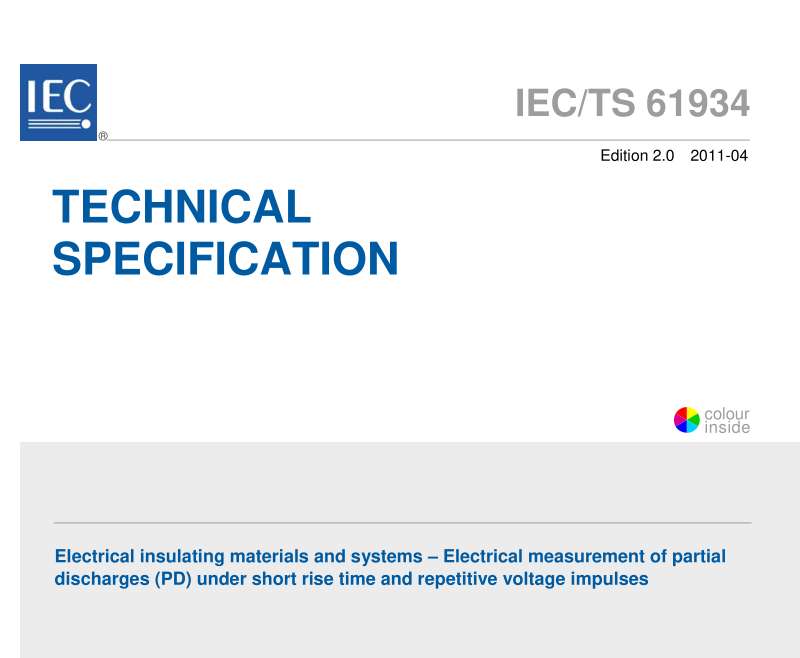IEC TS 61934:2011 pdfダウンロード

IEC TS 61934:2011 pdfダウンロード。Electrical insulating materials and systems – Electrical measurement of partial discharges (PD) under short rise time and repetitive voltage impulses
1 Scope
IEC/TS 61 934, which is a technical specification, is applicable to the off-line electrical measurement of partial discharges (PD) that occur in electrical insulation systems (EIS) when stressed by repetitive voltage impulses generated from electronic power devices.
Typical applications are EIS belonging to apparatus driven by power electronics, such as motors, inductive reactors and windmill generators.
NOTE 1 Use of this technical specification with specific products may require the application of additional procedures.
NOTE 2 The procedures described in this technical specification are emerging technologies. Experience and caution, as well as certain preconditions, are needed to apply it.
Excluded from the scope of this technical specification are
– methods based on optical or ultrasonic PD detection,
– fields of application for PD measurements when stressed by non-repetitive impulse voltages such as lightning impulse or switching impulses from switchgear.
2 Normative references
The following referenced documents are indispensable for the application of this document.
For dated references, only the edition cited applies. For undated references, the latest edition of the referenced document (including any amendments) applies.
IEC 60034 (all parts), Rotating electrical machines
IEC 60270:2000, High-voltage test techniques – Partial discharge measurements
3 Terms and definitions
For the purposes of this document, the following terms and definitions apply.
3.1
repetitive voltage impulses
voltage impulses which are used as test voltage for the evaluation of switching surges from power electronic devices with a carrier or driven frequency
3.2
partial discharge
PD
electric discharge that only partially bridges the insulation between conductors
[IEC 60270:2000, 3.1 , modified]
3.3
partial discharge pulse
current pulse in an object under test that results from a partial discharge occurring within the
object under test
NOTE 1 The pulse is measured using suitable detector circuits, which have been introduced into the test circuitfor the purpose of the test.
NOTE 2 A detector in accordance with the provisions of this technical specification produces a current or avoltage signal at its output related to the PD pulse at its input.
[IEC 60270:2000,3.2,modified]
3.4
repetitive partial discharge inception voltage
RPDIVminimum peak-to-peak impulse voltage at which more than five PD pulses occur on tenvoltage impulses of the same polarity
NOTE This is a mean value for the specified test time and a test arrangement where the voltage applied to thetest object is gradually increased from a value at which no partial discharges can be detected.
3.5
repetitive partial discharge extinction voltageRPDEV
maximum peak-to-peak impulse voltage at which less than five PD pulses occur on tenvoltage impulses of the same polarity
NOTE This is a mean value for a specilfied test time and a test arrangement where the voltage applied to the testobject gradually decreases from a voltage at which PD have been detected.
3.6impulse voltage polarity
polarity of the applied impulse voltage with respect to earth
[IEC 62068-1:2003.310]
3,7
unipolar impulse
repetitive voltage impulse, the polarity of which is either positive or negative
[IEC 62068-1:2003,3.8,modified]
NOTE The magnitude of the oscillation of the opposite polarlty has to be less than 20 %.
38
bipolar impulse
repetitive voltage impulse, the polarity of which changes
[IEC 62068-1:2003,3.9,modified]
3.9
impulse voltage repetition rateinverse of the average time between successive impulses of the same polarity, whetherunipolar or bipolar
[IEC 62068-1:2003,3.11modified]
3.10
impulse rise time
time for the voltage impulse to go from 0 % to 100 %
NOTE Unless otherwise stated, this is estimated as 1,25 times the time for the voltage to rise from 10 % to 90 %.
- Previous:IEC TR 62728:2011 pdfダウンロード
- Next:IEC TS 62224:2007 pdfダウンロード